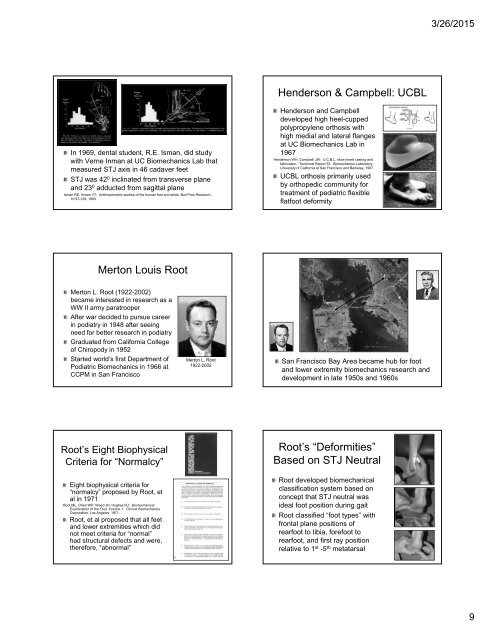History-Evolution-of-Foot-and-Lower-Extremity-Biomechanics-and-Foot-Orthoses_Kevin-Kirby
History-Evolution-of-Foot-and-Lower-Extremity-Biomechanics-and-Foot-Orthoses_Kevin-Kirby
History-Evolution-of-Foot-and-Lower-Extremity-Biomechanics-and-Foot-Orthoses_Kevin-Kirby
You also want an ePaper? Increase the reach of your titles
YUMPU automatically turns print PDFs into web optimized ePapers that Google loves.
3/26/2015<br />
Henderson & Campbell: UCBL<br />
In 1969, dental student, R.E. Isman, did study<br />
with Verne Inman at UC <strong>Biomechanics</strong> Lab that<br />
measured STJ axis in 46 cadaver feet<br />
STJ was 42 0 inclinated from transverse plane<br />
<strong>and</strong> 23 0 adducted from sagittal plane<br />
Isman RE, Inman VT: Anthropometric studies <strong>of</strong> the human foot <strong>and</strong> ankle. Bull Pros Research,<br />
10:97-129, 1969.<br />
Henderson <strong>and</strong> Campbell<br />
developed high heel-cupped<br />
polypropylene orthosis with<br />
high medial <strong>and</strong> lateral flanges<br />
at UC <strong>Biomechanics</strong> Lab in<br />
1967<br />
Henderson WH, Campbell JW: U.C.B.L. shoe insert casting <strong>and</strong><br />
fabrication. Technical Report 53. <strong>Biomechanics</strong> Laboratory,<br />
University <strong>of</strong> California at San Francisco <strong>and</strong> Berkeley, 1967.<br />
UCBL orthosis primarily used<br />
by orthopedic community for<br />
treatment <strong>of</strong> pediatric flexible<br />
flatfoot deformity<br />
Merton Louis Root<br />
Merton L. Root (1922-2002)<br />
became interested in research as a<br />
WW II army paratrooper<br />
After war decided to pursue career<br />
in podiatry in 1948 after seeing<br />
need for better research in podiatry<br />
Graduated from California College<br />
<strong>of</strong> Chiropody in 1952<br />
Started world’s first Department <strong>of</strong><br />
Podiatric <strong>Biomechanics</strong> in 1966 at<br />
CCPM in San Francisco<br />
Merton L. Root<br />
1922-2002<br />
San Francisco Bay Area became hub for foot<br />
<strong>and</strong> lower extremity biomechanics research <strong>and</strong><br />
development in late 1950s <strong>and</strong> 1960s<br />
Root’s Eight Biophysical<br />
Criteria for “Normalcy”<br />
Eight biophysical criteria for<br />
“normalcy” proposed by Root, et<br />
al in 1971<br />
Root ML, Orien WP, Weed JH, Hughes RJ: Biomechanical<br />
Examination <strong>of</strong> the <strong>Foot</strong>, Volume 1. Clinical <strong>Biomechanics</strong><br />
Corporation, Los Angeles, 1971.<br />
Root, et al proposed that all feet<br />
<strong>and</strong> lower extremities which did<br />
not meet criteria for “normal”<br />
had structural defects <strong>and</strong> were,<br />
therefore, “abnormal”<br />
Root’s “Deformities”<br />
Based on STJ Neutral<br />
Root developed biomechanical<br />
classification system based on<br />
concept that STJ neutral was<br />
ideal foot position during gait<br />
Root classified “foot types” with<br />
frontal plane positions <strong>of</strong><br />
rearfoot to tibia, forefoot to<br />
rearfoot, <strong>and</strong> first ray position<br />
relative to 1 st -5 th metatarsal<br />
9


